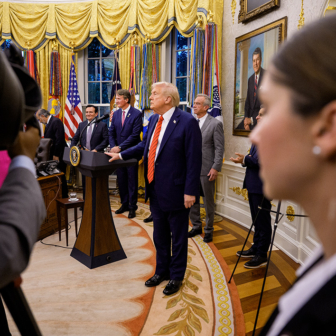Political leaders, medical experts and news anchors keep telling us we’re all in this coronavirus pandemic together. For this genuinely to be the case, we must also share a commitment to ensuring that our efforts to limit the spread and impact of the virus are needs-based and fair. And that’s much more difficult when the resources needed to preserve lives and livelihoods are in short supply.
An ethical framework for dealing with the pandemic has international, national, community and personal dimensions. They play out in the familiar conflict between the needs and desires of individuals and of the group, and in the ability of the well-off, and well-off countries, to get more benefits than the disadvantaged. Decisions made by policymakers in times of crisis, and how the community responds hold up a mirror to our national ethos. Do we like what we see?
The World Health Organization sees three broad ethical issues. Who gets priority access to healthcare resources? What are the obligations of healthcare workers in light of the risks to their own health? And how do we balance necessary isolation and travel restrictions with protecting the rights of individuals? When a pandemic has dramatic economic impacts, that list should also include the question of who gets financial assistance. Affordable childcare options, internet access and room to work at home create a gulf between rich and poor.
Some of the ethical issues should be relatively straightforward. We need to ensure that some groups of people aren’t more likely to get tested than others simply because of their status or connections. We need to keep cracking down on people who flout instructions about social isolation and quarantine, especially when the capacity of certain groups to protect themselves and their families is already compromised by the essential work they do — not just as doctors, nurses and carers, but also in transport and delivery, cleaning and food services, and garbage collection. Hoarding, too, is anything but victimless during a pandemic.
The thornier ethical dilemmas arise when the number of seriously ill people requiring acute care rises to a level at which hospitals and healthcare facilities cannot cope. That has been the case for several weeks in Italy and is increasingly the case in New York City.
In Australia, the government and its advisers have provided reassuring advice about the ability of hospitals to increase their surge capacity, and the rationales for how we can flatten the curve to avoid the pressures on intensive care. But if the most worrying scenarios were to play out, Australian hospitals would not have the capacity to accommodate possible demand, and some types of care — specifically intensive care, ventilators and respirators — would need to be rationed. This would not be a discretionary decision but a necessity, and the level of rationing would increase if significant numbers of healthcare workers were infected.
Efforts to increase testing and social isolation will come to nothing if a similar level of investment is not put into protecting healthcare workers in hospitals and carers elsewhere in the community. Yet daily there are stories about the severe lack of appropriate personal protective equipment. This adds to the stress and anxiety of people who face the constant risk of infection and worry about their own families. At their extreme, the shortages could have the dreadful consequences highlighted by stories from Europe.
In deciding who gets access to rationed care, the overriding principle will be one of utilitarianism — maximising the benefits produced by the scarce resources — in the knowledge that available intensive care treatments are by no means guaranteed to produce the desired outcome.
In the United States, a conversation is already taking place in public about how to ensure, when lifesaving resources are scarce, that hospitals have consistent, transparent guidance for patient care. These “crisis standards of care” prioritise the survival of the group over the survival of the individual patient during disasters. But although the US Centers for Disease Control and Prevention has outlined general principles, it’s up to individual hospitals, health systems and states to decide policy. The result is a patchwork system, with states including New York and Minnesota having drawn up detailed guidelines for allocating resources but others having yet to confront these tough issues. If the pandemic and ventilator shortages get as bad as the worst predictions, some envisage palliative care being offered to people who might have survived with intensive care.
In Italy, the peak body for intensive care medicine has published a grim guide stating that “resources may have to be used first for those with a higher probability of survival and, secondly, [for those who have] the most years of life left, and offer the maximum number of benefits to the majority of people.” Others reach the same conclusions. “If we give scarce treatments to those who don’t stand to benefit (and have a high chance of dying anyway), then not only will they die, but those with higher likelihood of survival (but require ventilator support) will also die,” says Lydia Dugdale, director of the Center for Clinical Medical Ethics at Columbia University. “It’s not fair to distribute scarce resources in a way that minimises lives saved.”
In Australia, rationing has been mentioned in passing, but whatever expert discussions are taking place are out of public view and don’t involve public consultation. In drawing up guidelines and making these decisions, hospitals and doctors will consider the number of co-morbidities, the severity of respiratory failure and the probability of surviving prolonged intubation — factors that are generally linked to the patient’s age. But as medical experts both in Australia and overseas have noted, the primary criterion for rationing should be the chance of survival, whatever a patient’s age.
Being on life support in intensive care is challenging even for young, previously healthy people; patients often require fifteen to twenty days of ventilation and then a slow weaning. Intensive care is hugely resource-intensive, involving sophisticated equipment and large numbers of trained staff. Even the process of intubating a patient to go on a breathing machine presents a major infection risk to the doctor involved.
If a patient in these circumstances is not doing well, is it ethical to give the ventilator to another patient with a better chance of survival? Who would make that decision and what would guide them? This question might be hypothetical now but could become real in a very short time.
Little discussed is the extent to which the use of resources for treating patients with Covid-19 limits the treatment of patients with other medical conditions. Patients will continue to present with trauma, heart attacks, strokes and even complications arising from seasonal flu, and they too will need intensive care and ventilators.
The challenge of balancing the needs of Covid-19 patients and patients with other serious conditions applies also to medicines. Media hype about the possibility of treating coronavirus infections with chloroquine, pushed along by Donald Trump in the United States and Clive Palmer in Australia, has led to international shortages of a drug normally used by patients with serious conditions like lupus and rheumatoid arthritis. Here in Australia, people have purchased asthma medications in case they need them, reducing availability for people with chronic respiratory diseases.
The life-and-death decisions that rationing will force will be made more difficult if doctors are hamstrung by unnecessary procurement failures and shortages, if the system is rife with access disparities for some segments of the population, and if there is insufficient support and guidance for how such decisions should be made.
International organisations like the WHO and the OECD have called for a global effort and international cooperation to tackle the coronavirus pandemic. However, a pandemic inevitably means that countries look inwards to their own needs. President Trump’s policies have worsened the problem in the United States. Developed nations are all reeling from their own disease burden, which has been exacerbated in some countries, including Australia, by a lack of forward planning that leaves them facing shortages of testing reagents and kits as well as medical equipment. The situation will be much worse for developing countries.
In the weeks ahead, will the world be willing to share resources, as China has done for Italy? Or will there be isolationism, as seen in reports that the Trump administration was seeking to buy a German vaccine “only for the United States”? Will Australia look to see what help it can offer to Papua New Guinea and Pacific island nations? And who will ensure that the millions of people in refugee camps get the help they need as coronavirus spreads relentlessly?
The American College of Chest Physicians’ statement on care during pandemics and disasters makes the case that focusing on ethical principles is not a luxury but an obligation, necessary to engender trust and alleviate moral distress and burnout in providers. Trust is in short supply these days, as scarce as personal protective equipment for healthcare workers; clear principles can go some way towards restoring it.
That is why Australia needs explicit guidelines for how it behaves internationally, nationally and at the community level when needed resources are scarce. These must be ethically grounded, transparent, publicly developed, effectively communicated to all, and regularly reviewed. Because one day history will hold us accountable for what was done and why in this time of pandemic disease. •




